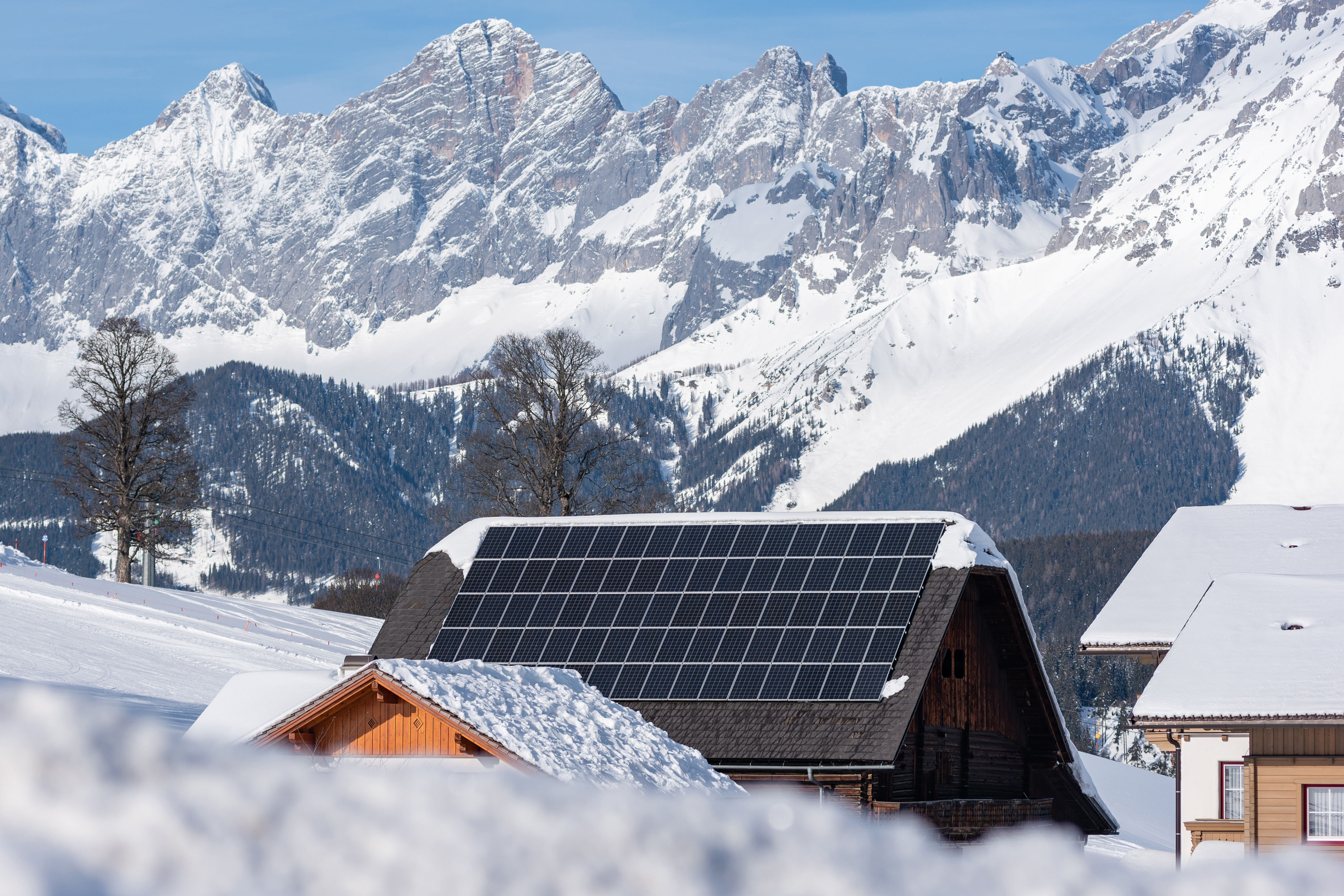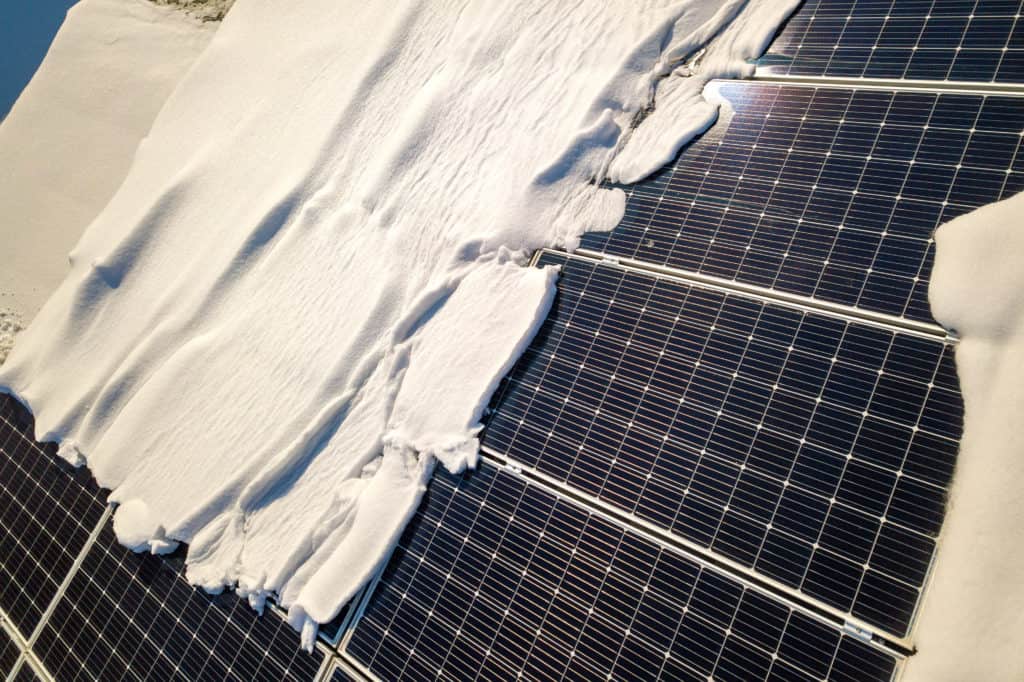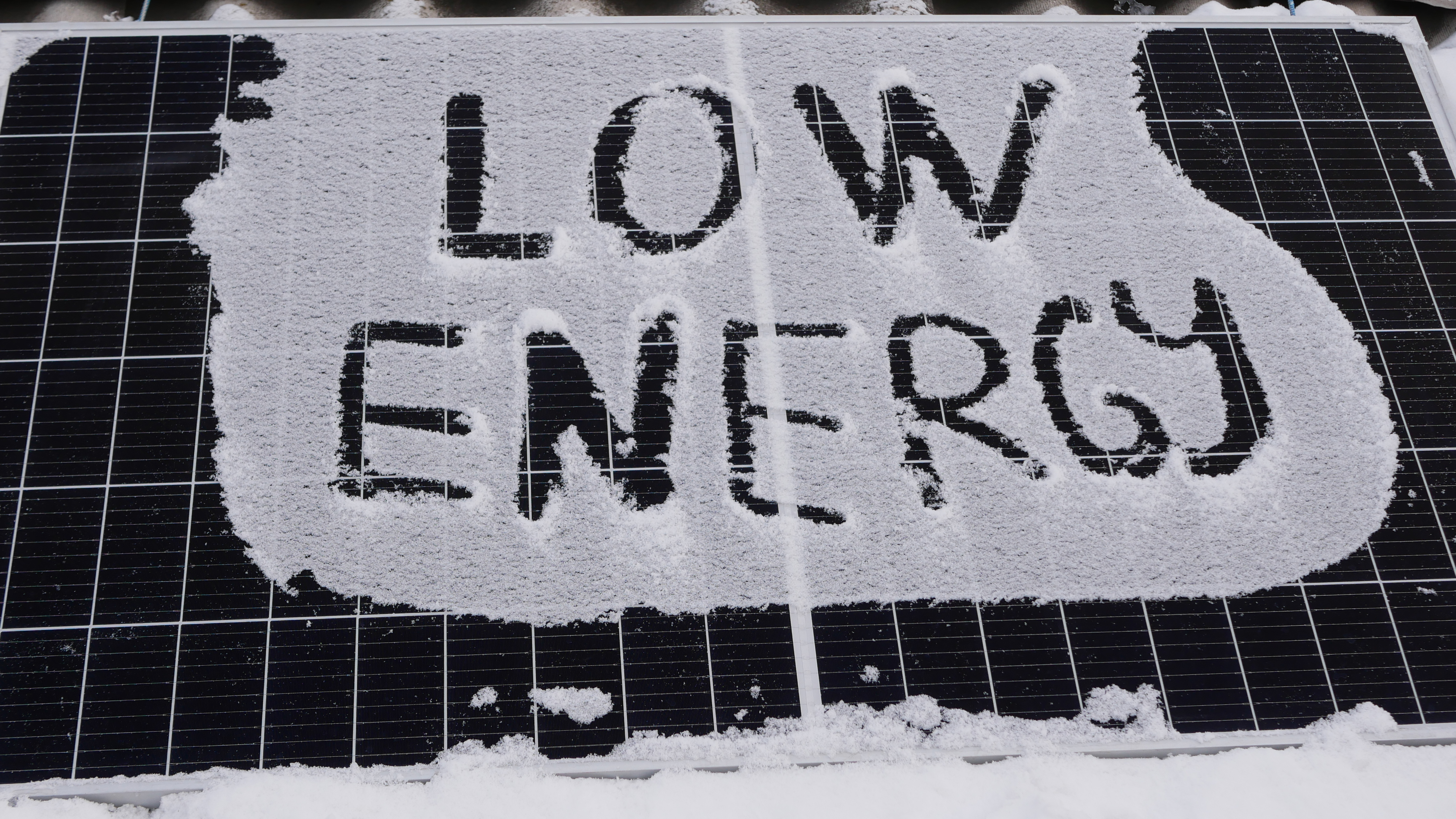
I don’t know about you, but when I think of solar panels I picture them in deserts and other warm, sunny areas! However solar panels are adaptable and can provide energy in a wide range of temperatures and climates. But when solar panels are installed in cold areas, there’s a high possibility that snow will fall on them during the cold months.
Because of the slope and heat-producing abilities of solar panels, you can usually wait for the snow to slide off on its own. If there’s thick snow though, you can sweep it off or use lukewarm water to loosen the buildup. Never use chemicals to remove snow because this could void your warranty.
Most snow that lands on solar panels will melt or slide off on its own. Solar panels are smooth and it’s not easy for snow to stick to it. Manual methods of snow removal are best, not chemicals or hot water. To learn more about safe snow removal methods and solar panel’s relationship to temperature, read below.
How To Safely Remove Snow
When solar panels are producing electricity, they’re usually warmer than the air around them. This means that a lot of snow that falls on them will melt on contact. Sloped panel arrays and systems that have been installed on tilted roofs also have gravity on their side.
Because of these features, the majority of snow that falls will melt or slide off by itself. There isn’t usually any need for extra help. The best tactic to take is usually to just wait it out and let the snow melt over time. It will happen faster than you might think!

However snow can still build up on panels in cold weather. If solar panels are blocked and can’t receive light, they won’t be able to produce electricity and warm up. When this happens, they may need to be cleaned off in order for them to do their job.
If you’re on the fence at all, do not try to remove the snow yourself. If you use harsh methods or accidentally hit the wrong area with a snow removal tool, you could damage the panels and possibly void your warranty. There’s also a possibility that you could slip and fall if you’re cleaning rooftop panels in icy conditions.
But if you’re determined to clean the panels yourself and you can’t wait for the snow to melt, there are a couple of tactics you can use to remove snow.
- Manually remove snow with a brush, snow rake, or long-handled squeegee. This method is good for removing a fluffy outer layer of snow, but not ice that has frozen to the under layer.
- Hose off the panels if the temperature is above 32 degrees. This is a quick way to loosen snow and ice and will leave the panels without any chemical residue. Do NOT use this method if you expect a temperature drop within the next few hours. Water from the hose could end up freezing onto the panels and causing bigger problems overall.
- Blow the snow off. When dealing with snow removal, some solar panel owners have used leaf blowers and other air-powered tools to great effect. Again, this is a good method for removing light and fluffy snow layers, but won’t do as much against heavy, wet, or frozen buildup.
- Hire professional cleaners. There are many qualified solar panel cleaners in today’s world. They can clean debris off panels in warm weather and remove snow in the cold months. These cleaners may be a bit expensive though, so really consider the pros and cons of waiting for the snow to melt by itself.
The methods listed above are the safest DIY ways to remove snow from your solar panels. There are a few things you should avoid at all cost though.
First of all, do not use freeze-proof chemicals on the panels. This could include things like rock salt, car wax, or chemical ice-melts. These might work well on driveways or windshields, but they can strip away the weatherproof coating of solar panels and permanently damage them.
If you choose to use a hose to remove snow buildup, make sure it’s within a safe temperature range. Solar panels that are cold and/or have a layer of ice on top will be more sensitive to changes in temperature. If hot (or even warm) water is poured over them, they might crack.
Water that’s between 40-50 degrees is your best bet. Go for cool/lukewarm water for the best effect. This will help remove snow, while gradually increasing the temperature of the solar panels.
Finally, be very careful if you’re removing snow from rooftop solar panels. Make sure someone is watching you and always use a sturdy ladder and shoes with good grip. However, even under the best of circumstances this can be quite risky. Think seriously about the benefits of waiting or hiring professional help.
Solar Panels And Temperature

You might think that winter and cold conditions don’t agree with solar panels. I usually think of solar panels working best on the warm, bright days of summer! They actually have quite a complicated relationship with temperature though.
While solar panels can function and produce electricity as long as they receive sunlight, they actually tend to work best at cooler temperatures! Electronic devices produce heat as they work and they can often overheat and slow down their overall efficiency.
Solar panels definitely need the sun in order to work, but a hot outdoor temperature plus the heat that they produce can make them overheat easily. This temperature overload isn’t good for them and solar panels can actually lose between 20-40% of their efficiency during very hot days.
So although it might sound counterintuitive, cold, bright winter days are usually the best conditions for solar panels! As long as your solar panels aren’t obstructed by snow, winter can be the best season for energy production.
Panels are usually quite efficient between 41-77 degrees Fahrenheit. This is the standard testing range that production companies use, and you can rest assured that your panels will run well at these temperatures. 18 degrees Fahrenheit is the ideal temperature though, so those cold winter days can help reach this heat level.
Solar panels can even hold up under -18 degree weather, so cold isn’t really a problem. Don’t worry about cold snow damaging the panels. They can stand up to the freezing temperatures and even come out better for it!
Solar Panel Damage And Warranties

Solar panels can be quite expensive to purchase and install, so it’s important to protect your investment. Solar panels can eventually pay for themselves and provide you with extra energy and funds, so it’s important to maintain them over a long period of time to get the most bang for your buck.
Most reputable solar panel manufacturers offer warranties on their products. Warranties include terms of use and agreements that give solar panels certain protections and safeguards.
Warranty Benefits and Terms:
Warranties can cover costs and damages from things like incorrect panel installation or faulty equipment.
There are 3 main areas that solar panel warranties protect against. These warranties are performance, (which ensures that your solar panels are producing the appropriate amount of power) equipment (which covers costs from components or equipment that break under normal use), and workmanship (which provides buyer protection against human error and installation mistakes).
These agreements help to guarantee the performance and quality of your solar panels as long as the panels are properly maintained.
Most solar panel companies offer warranties that last between 10-25 years. If you see warranties that last less than 10 years, that could be a warning sign of a faulty product because solar panels are designed to last for a long time.
Voiding a Warranty:
Solar panel manufacturers have provided several avenues and resources for repairs, maintenance, and upkeep. Warranties are great protections against a variety of unforseen problems, but they are not a catch-all.
Snow removal is not always covered under warranties, so it’s important to consider how your actions might affect this agreement.
Owner actions (and inaction) can sometimes play into whether or not a warranty is still valid. For example, damage from fallen tree branches may not be covered if the offending tree was placed too close to the panels.
In the same vein, damage from improper snow removal could destroy your solar panels and void your buyer’s warranty. Once a warranty has been voided, the owner will have to pay for any following damages out of pocket.
So if you’re thinking about cleaning your solar panels or hiring an outside crew to do it for you, it’s always safest to consult with your solar panel provider first. They’ll be able to tell you if those actions are protected under warranty and provide you with alternative resources if not.
Taking your own DIY cleaning measures can cause more harm than good and could end up costing you a lot of time and money in exchange. It might seem simple to clean your own solar panels, but in most cases, it’s best to leave them alone or leave them to the professionals.